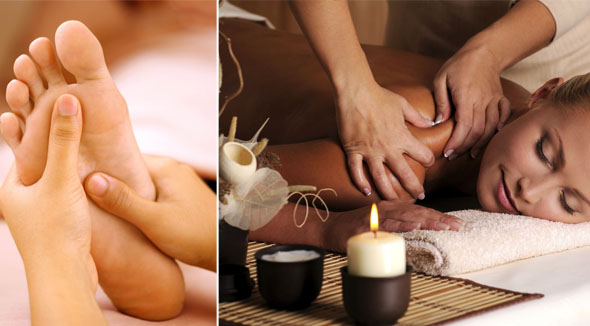The Art of Classical Thai massage was influenced by the ancient cultures of China and India. It has acquired its present appearance as a result of long practice, observation of the nature of human body, and through trial and error to create a clear system of recreational therapy.
The founding father of Thai massage is considered Dr. Jivaka, the personal physician of one of the Indian kings, who ruled for more than two thousand years ago. Thai massage is often used for therapeutic purposes in conjunction with Thai traditional medicine. The masters passed down the ancient knowledge from generation to generation through individual learning. A thousand years ago, when there was no writing, this knowledge could not be documented until Sukhothai period, when the king Ramkhamheng laid the foundation of the Thai literacy in 1277. It is believed that massage masters of that time were already capable of documenting their knowledge up until the Ayutthai period, but the complete destruction of Ayutthaya by the Burmese in 1765 left no records of the massage system.
Documentary evidence of the teachings can be found only from the early Bangkok period, in particular, during the reign of King Rama III and Rama V.
King Rama III in 1832 founded the first university in Thailand at Wat Pho, which was the first institution of higher education to train ordinary citizens. On sixty marble slabs and on the walls of the temple, there are images and charts of the impact lines on the body and acupressure points. At the same time, eighty statues were made depicting the stretchings and postures of yoga, twenty-six of which are still in the Pho Wat.
In 1870, King Rama V ordered the collection and rewriting of texts on Thai traditional medicine, Thai massage and yoga. This work was completed in 1906.
There are several names for this type of massage: traditional Thai massage, Thai Yoga, "Peng nuat borane» (Nuat phaen boran), passive yoga, and others. There are over seven types, or schools, of Thai Massage in Thailand: in the southern regions, more is attention paid to acupressure, whereas in the north, more attention goes to stretching in yoga-like positions. Founded on the basis of Indian Ayurvedic medicine, Thai massage is a treatment method implemented by stimulating biologically active points and performing a set of exercises derived from yoga practices.
Thai yoga massage is referred to as "passive yoga"—you take certain postures and relax in them while the master stretches, twists and kneads your body. In self-training it is difficult to work out all muscle groups, and some of them overextend. As a result, the overall balance of muscular and ligamentous corset of the body is disturbed.
Another advantage of Thai massage is the large number of twists and movements in the joints. This is a kind of passive exercise and stretching. Literally, in 5-10 minutes after the start of a session of Thai massage, you find yourself in a state of deep relaxation.
The duration of the procedure is different for every patient and is defined by the therapist individually, based on the physical condition of the patient.
Experienced Thai masseurs (and not less experienced masseuses) sense with their fingertips where biologically active points are located on the patient’s body, as these points have a higher temperature than the general body temperature.
While carrying out these procedures, no lubricants are used (massage oil equivalents), but just a little bit of essential aromatic oils to create an appropriate atmosphere and mental relaxation of the patient. Throughout the session, the therapist painlessly twists and stretches all the joints and the spine. The pressure is achieved by applying feet, elbows and wrists.
Thanks to this forceful but gentle influence, it is possible to work on the deep muscles and tissues of the body. Eventually blocks are removed, and the energy flows freely through the body, giving the person’s entire body an extraordinary feeling of lightness. All of the internal organs begin healing and restoring.
Thai massage is very effective for the musculoskeletal system restoration by helping to restore joints and spine mobility. The patient undertaking Thai massage is an active participant in the process, helping the specialist carry out therapeutic procedures. Some of them are performed by lying on the back, chest, or by sitting.
A combination of acupressure with techniques aimed at developing joint flexibility stimulates the removal of toxins from tissues, and has a beneficial effect on the immune system. However, you will also feel a clear increase in your overall tone, both physical and mental, after 2-2.5 hours. Achieving a good workout in all areas requires a lot of time.
Thai massage restores harmony and balance in all body systems.
Yoga massage is done in comfortable clothes, while lying on a mat. Unlike Western massage techniques, a master not only uses his hands, but also elbows, knees and even feet. This allows to effectively work on energy lines and pressure points, and perform a deep kneading, stretching the muscles and soft opening of the joints.
Thai massage is a meditation
Calm Thai music, aromatherapy candles, and a masseuse’s friendly attitude—all contribute to harmonious and meditative immersion and relaxation.
A relaxation
Relieves stress and soothes
Gently corrects your posture
Best Stretching
Removes the stiffness and tiredness of muscles
Restores the entire muscular system
Relieves pain and discomfort in the back and muscles
Is an anticellulite massage
Helps to lose weight
Activates the circulation of energy in the body
There are some restrictions to visiting medical Thai massage sessions, about which you should consult with your physician.